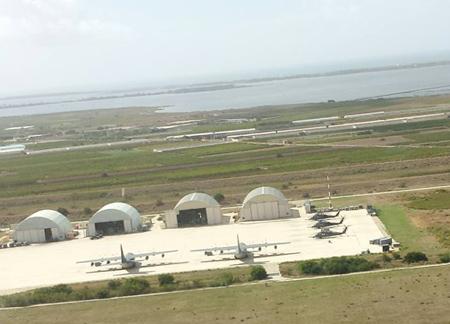They fly at low altitude to elude the opposing radar systems, trying to confuse the noise generated by the moving rotor with the wind blowing on the trees. Usually they fly in a fan formation, in a staggered position and on board carry elements of special departments.
The helicopters have a complete avionics suite which also allows them an electronic warfare capability. They can also be armed with 7,62mm rotating barrel miniguns, cannons and rockets.
The assault helicopters, once they reach the target, quickly descend up to one meter from the ground, remaining in hovering for a few seconds. That is the most dangerous time for an infiltration because cargo and aircraft are defenseless. But those two seconds are needed to explain the eleven team members who, immediately, create a defensive perimeter around the aircraft to saturate the area.
Helicopters never land in the same place, but possibly in positions and with different infiltration techniques. The target is usually at the center of an imaginary triangle, where each vertex represents a landing and takeoff point.
The teams on board can have different tasks: establishing a defensive perimeter waiting for reinforcements, breaking into a building, eliminating the threat, securing possible hostages inside and fleeing within seconds. When possible, special departments operate at night. Their complete individual equipment, made up of light intensifier and thermo-chamber, allows it to operate in any weather conditions.
This could be one of the many prefaces for an article on special departments: whether they are allies or not, the practice (on paper) is the same. When not parachuted or landed, the elements of the chosen units are infiltrated and exfiltrated by helicopters, suitably modified. Whether they are Black Hawk, Little Bird or Chinook (at least for the West, at least those publicly known even if AirWolf is no longer a mystery), the task of the helicopters is only one: to deploy the troops and bring them back to safety as soon as possible. possible time.
But do these exercises take place in Sicily?
Sure. The Italian bases present are at the forefront of unlit reflectors. On the island there are two NATO bases: Sigonella, in the province of Syracuse and Trapani.
Sigonella, headquarters of the 41st Stormo Antisom of our Air Force, also hosts the logistics command of the US Navy's Sixth Fleet and is a launching pad for most of the operations taking place in the Mediterranean.
Trapani, instead, home to the 37 ° Stormo AMI, is also a base of NATO, therefore, par excellence, houses vehicles and men of the allied countries.
The main track of the military airport of Trapani is also open to civil traffic. This means that during the landings and takeoffs of civilian aircraft, the military base (with attached risky aircraft) can be photographed by anyone.
In the last few months, an unspecified Nato contingent has been put in danger of the main runway.
The photos immortalize some Black Hawk helicopters. No wonder: Sicily, due to its conformation, has numerous uninhabited and uninhabited areas, with different types and contexts (plains, mountains, cliffs, bunkers from the Second World War, eco-monsters). It is easy to assume, therefore, that NATO contingents are exercised throughout the island.
But, exactly, what have they photographed those who, unknowingly, wanted to capture only the last memory of their stay in Sicily?
The helicopters photographed are Black Hawk twin turbines. The coloring is typical of the aircraft: each helicopter is armed with two 12,7 mm machine guns on the sides of the fuselage. If the department to which it belongs is unknown, we can try to establish the model of the Black Hawk. Those immortalized are MH-60G Pave Hawk (where Pave stands for Precision Avionics Vectoring Equipment), used for special operations for land and sea missions. Clearly visible on the nose, the infrared radar to better allow the crew to follow the contour of the terrain and avoid obstacles during the night. It is a highly modified variant of the UH-60A Black Hawk, with increased capability in range (stamina), navigation, communications and defensive systems.
These helicopters photographed in Trapani, come from Sigonella?
Officially the base in the province of Syracuse does not have the Black Hawks equipped nor has it hosted, at least in recent times, special departments. In fact, Sigonella officially hosts marine departments. But it is more than normal that the base, due to its strategic role as the "Hub" of the Mediterranean, is "visited" by any other American department.
So, who are they?
They are soldiers who operate aboard heavily modified and armed USAF helicopters. Their type of mission is search and rescue or C-Sar in hostile and non-hostile territories. They are certainly American soldiers and belong, for the aircraft in their possession, to a highly trained unit.
They could be men of the 56 ° Rescue Squadron, a department officially deployed at the base of the 48 ° Fighter Wing in Lakenhealth, England. They are undoubtedly men of special departments and for their type of arrangement could be "Pararescueman" or PJ.
To operate in Italy, they have certainly received special authorizations to fly over and operate in areas close to those inhabited. Whether they took off from an aircraft carrier in transit on the Mediterranean or from a distant 650 km (this is the Black Hawk radius without refueling), these men are still "good guys" and act "so that others can live"
Franco Iacch












